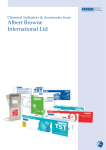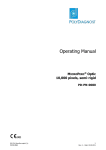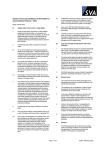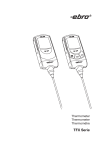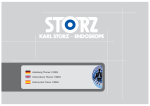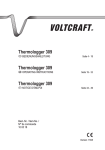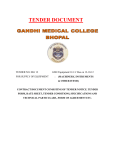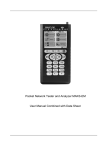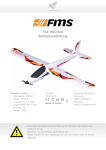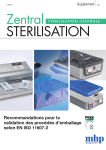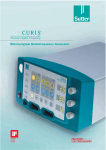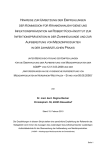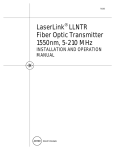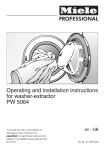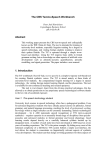Download PDF 下载 – 第19卷 - CLEANICAL GmbH
Transcript
International FORUM 2013 Medical Devices & Processes Volume 19 Medical Device Processing: Manual Skills and Residual Risks Best of FORUM 17–18 Chirurgie-Instrumenten Arbeitsgruppe (CLEANICAL®) Berlin in cooperation with Brandenburgisches Bildungswerk für Medizin und Soziales e. V. under the auspices of Deutsche Gesellschaft für Sterilgutversorgung e. V. SAFETY FOR EVERYONE www.wolf-corporate.de Top-Innovator 2013 NEW: independent labelling and documentation system > Integration of all sterile barrier systems (sealable pouches and reels, sterilization sheets, reusable containers) > Easy import of the desired printing information via a scanner without an additional computer > Printout of all relevant information incl. the designation of instruments or sets > Documented approval decisions after packaging and after sterilisation > Easy documentation in the patient file > Seal check function > The following labels are available: STEAM, STEAM/EO, STEAM/FIRM and VH2O2 Member of: [email protected] · www.hawo.com FORUM Medical Devices & Processes 2013 Editorial | 1 Manual skills and residual risks S ome things we can «grasp», others we need to understand. Even so-called «validated processes» must be performed every day by people with their hands and minds. But what good is a validation of the technical equipment , when the packing station is chaotic? Looking at the various rules, laws, technical regulations, standards, guidelines and recommendations for hygiene in the reprocessing of medical devices, one can easily lose track: What is important, what is right? What is redundant or even superfluous? Currently, ISO 17664 is under revision and the European Directive is being renewed and will no longer have to be transferred into national law. The diversity is irritating, concerning the sheer number of rules and the inconsistent use of some terms. Example: What do I expect when asking for biocompatibility or how do I actually test if a material is pyrogen-free? A claim is worthless if the performance is not verifiable. And we are not even talking about actual and unannounced inspections, which are apparently planned with the new European Regulation. What is remarkable about the development of such rules is that they are always trying to encompass «everything», while not everything is testable; some items therefore remain floating suggestions – or rather requirements – and leave the problem of feasibility to the users. He feels the burden of responsibility, but often feels left alone when he is looking for concrete aid in the regulations. What is missing here, is the acknowledgment of the limits of controllability, a sense of permissiveness. Millions of instruments are handled every day in order to produce medical devices for an intended use again: they were contaminated and now, by means of a procedure, become sterile again – at least it is the unprovable goal that at the end of this process we do have sterile medical devices – packaged in a sterile barrier system. A proof is possible only through a destructive test, where the medical devices are removed and examined for growth of microorganisms. This measure of quality assurance is recommended for control sampling, which has to follow an independently created test plan. Using the example of so-called «workshop instruments» it becomes clear, however, how the term «medical device» determines certain procedures («intended use»). These instruments were used in workshops, in the context of doctors' and nurses' continuing education (surgical exercises), where they might have come into contact with animal tissues to some extent. In some cases, such tissue contact is simply not denied afterwards and therefore – for safety reasons – presumed to have happened by the staff responsible for returning the instruments to the manufacturer. And so they get labelled accordingly. Do such instruments need to be discarded then for ethical reasons or can they be led back to their intended purpose on a human patient, after proper reprocessing? What would be necessary for that to happen and which differences exist? Do we believe in the effectiveness of our processing measures? The problem is not as marginal as it appears at first sight: with 2,000 hospitals and their surgery departments in Germany, and with the high number of new instruments (and the corresponding need for training), there is a tremendous amount of medical devices, that the respective manufacturers have to process in some way – or have to throw away. An appropriate risk assessment of «workshop» medical devices must of course be based on as much sound information as possible regarding their use, e.g. did tissue contact with animals and/or body tissues (including corpses) presumably or actually take place? Such documentation would help in the selection of appropriate processing steps. What is not helping are the «worst case» scenarios, which have unsettled reprocessors for two decades now, when it comes to the perceived prion risk. Even 20 years after the peak of the «mad cow disease» in Great Britain, most people are still reading their newspaper the right way around, to name a possible symptom. Neither in daily life nor through surgical contacts did a significant number of transmissions happen, although it is possible to provoke it in animal experiments by direct inoculation of infectious material into brain tissue. Regarded by epidemiological criteria, the risk of a BSE epidemic has been irrelevant these twenty years. What is highly relevant, on the other hand, are infections with staphylococci, streptococci, tuberculosis and spore-forming chlostridiae and, of course, MRSA. Therefore, we sterilize instruments after proper processing and hope that an infection has been rendered impossible by the chosen process. Experience seems to prove us right, because there is still no evidence for a systematic transfer by faulty processing. That would be documented and stand out in the benchmarking of the clinics. A hygiene rating, therefore, should be less about the «modern» dangers, recently described by science, like prions and the cause of TSE (transmissible spongiform encephalopathy) or vCJD (variant Creutzfeldt Jacob disease), but primarily about the prevention of transmission of ubiquitous spore formers, that might sit under your shoe sole right now, such as clostridium, tuberculosis bacteria, staphylococci and streptococci, as well as various parasites. I assert that the lethal risk from a reprocessed single-use cardiac catheter is higher than the risk of dying from a prion-related disease. This remains an assertion, since comparative figures are not available (to me). For both cases it remains to be proven, but who is counting the incidences? Courts of law tend to use the (less elusive) concept of organizational culpability as the causative fault in liability cases. Here in Germany, less than 1,000 deaths have been documented in the last 20 years, that could be linked to prions, more than 200 of which were related to one special method of dura mater grafts. At this point we need more epidemiologically reliable statements about the actual risks of these so-called «slow virus infections». 2 | Editorial FORUM Medical Devices & Processes 2013 As it is, we do not see such a «specific» risk of infection, and rather a confusion of cause and effect: a misfolded protein («prion») does not know whether it is a medical device that it rests on. If there really were a specific «prions» danger, any and all reprocessing of medical devices would be threatened by such aimless settlement: professional and proper hygienic processes are either able to «defuse» potential risks for the following patient or they are not. It will be recalled that Florence Nightingale was able to protect her patients quite effectively with her sterilization procedure, derived from cooking jam, against «lockjaw» or «gas gangrene» after amputations. The names of these infections impressively describe what they are: disease names that were obtained from clinical observation (in the sense of looking), as described during wars by soldiers and paramedics, later adopted by medical science. The point being that intuition and experience have led us to the method of steam sterilization. Why do we no longer trust our experiences – amongst other factors – when it comes to risk assessment? There is an overemphasis of the knowledge obtained in laboratories under artificial conditions, that superimposes our obvious and documented experience. Wanting to be «on the safe side» may also prompt us not to use a bridge that leads forward and enter uncharted territory. Many new surgical techniques necessitate a trade-off between preventive hygiene requirements and functional-surgical requirements, e.g. miniaturization: the protection of human tissue that is not being cut, on the one hand, on the other hand the risk of a possibly lower degree of hygiene and of potential contact with residual pathogenic microorganisms, as may be the case with «needle scopic» surgery. What is fact, what is merely an assumption? We will only find out when we try – under defined conditions, of course, so the success can be evaluated. The benefit must therefore be studied and analysed, which may be (but does not necessarily have to be) done via clinical trials. Manual skills determine the quality of reprocessing, supported by technical equipment which, however, needs to be loaded and operated correctly. «Residual risks» remain in a double sense: we may have «residuals» of unknown infectious potential. And we have, after a trade-off, a «residual risk» with the reusable instruments. In fact we even have risks with new single-use instruments, which may malfunction or carry residues from production processes or be burdened with bio-incompatibilities. Finally, we have recently seen reusable mechatronic manipulators, whose placing on the market in the European Union was possible, interestingly, although no validated cleaning method according to CEN ISO 17664 was presented (the author was able to witness this in 2008). It remains to be seen if this situation has improved, now that specially designed load carriers are available. Ultimately, once a manufacturer has placed their product on the market, it is up to the operator to assure the good quality of these «reconditioning measures» that we call reprocessing (see volume 16 of the International FORUM Medical Devices & Processes). Dr. med. Dipl. Ing. Thomas W. Fengler Cleanical Investigation & Application www.cleanical.de Masthead Content: Manual skills and residual risks 1 Editorial Cleaning 4 W. Michels: Standardisation of Cleaning Efforts and Manual Precleaning of Robotic Instruments Packaging 8 C. Wolf: Package labelling and packaging process documentation Sterilization 10 14 C. Witte: STERRAD® H2O2 plasma sterilization – the efficient alternative for sterilization of high-tech medical devices Moisture in medical device units (MDUs) Validation 16 18 I. Kruse: New Thermologger Sets R. Graeber, A. Hartwig, T.W. Fengler: Standard Operating Procedures according to the German KRINKO 2012 Hygiene 21 24 A. Hartwig, T.W. Fengler: Hygiene at the MD-Related Workplace Processing is always – at least partly – a manual task... Best of Vol. 17 – 18 Editor Dr. med. Dipl.-Ing. Thomas W. Fengler Publisher mhp-Verlag GmbH, CEO Andreas Klein, Marktplatz 13, 65183 Wiesbaden, Germany. Tel.: +49 (0) 611/505 93-131, Fax: -11, E-mail: [email protected] Editorial Staff Dr. med. Gudrun Westermann, Tel.: +49 (0) 611/505 93-134, Fax: -11 E-mail: [email protected] Script coordination Ronald Graeber Printing Druckerei Chmielorz GmbH, Ostring 13 65205 Wiesbaden-Nordenstadt, Germany Paper Terraprint mat «chlorine free», 80 g/sqm Copyright All rights reserved. No part of this publication may be reproduced, transmitted in any form or by any means without the prior written permission of mhp-Verlag GmbH. One photocopy of individual articles or parts thereof may be made for personal use only. © mhp-Verlag GmbH 2013 Trademarks The use of general descriptive names, trade names, trademarks, etc., even if these are not especially identified, is not to be taken as sign that such names may be used freely by anyone. Editor in Chief and publisher do not guarantee for articles published outside the editorial part of the journal (esp. advertising, industrial information). Authors who are mentioned with their full name and who are not member of the editorial staff publish articles in their own responsibility. Publication in Preparation: In Vorbereitung: Volume 20 of the series FORUM Medical Devices & Processes Only clean medical devices function safely Nur saubere Medizinprodukte funktionieren sicher will be published in March 2014 FORU Mediz Interna tionales M 20 14 inproduk te & Pr Schrifte ozesse nreihe Band 20 Nur sa ubere Mediz funktioni inproduk eren si te cher. Chirurg ie-Instrum in Koop eration enten A rbeitsg mit Brande ruppe nburgisc (CLEAN hes Bild ICAL ®) unter de ungswe Berlin r Sch rk für M Deutsch irmherrschaft von edizin e Gesell und So ziales e. schaft für Ster V. ilgutver sorgun g e. V. 4 | Volume 19 FORUM Medical Devices & Processes 2013 Developments for standardization of cleaning efficacy and manual precleaning of robotic instruments C leaning is the first, and an important, step when reprocessing the instruments used for surgical procedures. Its purpose is to assure the effectiveness of the subsequent steps, i. e. disinfection and steam or low-temperature sterilization. In addition, cleaning is designed to minimize transmission of residual soils when the instruments are reused on other patients. || Verification of cleaning efficacy Cleaning efficacy cannot be assessed exclusively on the basis of a reduction of organic soils to such an extent that the reprocessed items are visibly clean. Indeed, several instruments with gap regions, joints, lumens, etc. do not at all lend themselves to visual inspection. Therefore an appropriate method must be used to assess cleanliness, and presently this is chiefly done through selective elution of such instrument regions with a sodium dodecyl sulphate (SDS) solution and protein detection. The acceptance criterion used hitherto was a residual protein amount of less than 100 µg per instrument. However, the DGKH, DGSV and AKI Guideline* states in a footnote that, in the case of instruments with everyday soils, acceptance criteria that differ from the specified values can be applied to instruments used in special settings (e. g. ophthalmology) subject to risk analysis. But since it is very unclear just what should be the focus of such risk analysis, that suggestion is rarely taken up in practice. * Guideline compiled by the German Society of Hospital Hygiene (DGKH), German Society of Sterile Supply (DGSV) and the Working Group Instrument Preparation (AKI) Assessment needs to be based on the respective surface area because this is the only way to harmonize the results obtained e. g. for a delicate root canal instrument with those for an orthopaedic intramedullary reamer. The working groups responsible for the guidelines compiled by the DGKH, DGSV and AKI for validation of automated as well as manual cleaning and disinfection will now set the acceptance criteria in line with the respective surface area (at < 3 µg/cm2), thus taking account of the ancient wisdom of Paracelsus who stated: «Poison is in everything, and no thing is without poison. The dosage makes it either a poison or a remedy». The effectiveness of the post-cleaning process steps is in any case determined by the layer thickness of any residual soils persisting after the cleaning step, since this helps to protect embedded microorganisms against the reprocessing agents (disinfectants/sterilants). Likewise, the residual protein amount that can be transmitted when reusing an instrument depends on the instrument surface area that comes into contact with the patient and the protein amount that can be passed on at that time. This means that the chief determinant here must be contamination burden in relation to a particular surface area. This amendment is accompanied by the demand that when inspecting, after cleaning, instruments contaminated during everyday use, the focus should definitely be on those instrument parts primarily contaminated during use, and presenting the highest transmission risk on reuse. This demand is made because in the majority of cases hitherto, while only sections of instrument surfaces measuring less than 33.3 cm2 have been sampled (and, accordingly, the acceptance value of < 3 µg/cm2 W. Michels Fig. 1: MIS loading trolley with missing silicone support at the right front – the pressure in each flushing device is more or less lowered, but constant is much less than < 100 µg), the value obtained was then applied as a flat-rate value to the entire instrument, i. e. its entire surface area. That meant that the detected protein amount was distributed (across the entire instrument), despite it perhaps having been confined to a particular, critical, site. This will no doubt mean that more and more unacceptable instrument regions will be identified, needing recleaning and standardization of the cleaning methods used. || Standardization – achievements and efforts Since the first edition of the DGKH, DGSV and AKI Guideline was published in 2006, the cleaning processes have been revised and optimized in line with the experiences gained from validation in the field. For example, today automated cleaning of surgi- Dr. Winfried Michels, c/o Miele Professional, Carl-Miele Str. 29, 33332 Gütersloh E-mail: [email protected] FORUM Medical Devices & Processes 2013 cal instruments is carried out mainly with detergents that have pH value > 10, whereas mainly neutral detergents were used during the 1990s. Demineralized water is used for the cleaning step in more than 85 % of all processes. Again, in over 85 % of all processes evaluated, the cleaning time is 10 minutes. Nonetheless, there is still a need to develop more effective detergents. As regards the mechanical cleaning action, the requirements for validation of a constant cleaning pressure in washer-disinfector process steps as well as verification of the rotational speed of the cleaning arms have resulted in improvements, which to an extent have now been standardized. The reason to test that a constant cleaning pressure is used, or verify that this is kept within a defined cleaning pressure range, is to show whether there are any negative interactions between the chemical substances and/or soils with the mechanical cleaning action because of foam formation. Hitherto, the pressure level here was not relevant, i. e. this was independent of a minimum pressure needed to ensure that successful cleaning could, at all, be expected. A review of validation reports revealed that there were significant differences in the pressure values measured at positions in the loading trolley used to flush similar instrument lumens – and these differences were more pronounced if loading trolley fittings were missing or defective. For example, if a silicone support is missing in the loading trolley, as illustrated in the Figure 1, the pressure drops significantly at the adjacent nozzles, but the requisite constant cleaning pressure is assured for the various process steps. This raises the question of what minimum pressure is needed at nozzles and adapters in the loading trolley. This can be answered only by the washerdisinfector (WD) manufacturer, who must collect the relevant data for each loading trolley and its intended purpose during the type test; he must define a specific minimum pressure and publicise this accordingly. This constitutes a very important requirement, which must be incorporated into the validation guideline. Likewise, we have absolutely uncontrolled conditions and deviations for manual precleaning of instruments which, often, do not comply with the manufacturer’s instructions. For certain minimally invasive surgical instruments it is recommended that their lumens be precleaned for a certain time at a particular minimum pressure and only then should they be exposed to an automated process. But this can only be done in a reproducible manner, under unchanging conditions, if the spray pistol is fitted with a manometer, something I have to date never seen in a Central Sterile Supply Department (CSSD). These are examples of issues that must be addressed in standards and guidelines by defining appropriate requirements for them. But, unfortunately, the relevant standards, in particular, are lagging behind the current state of the art in science and technology. Instrument cleaning based on the cleaning arms’ technology holds out prospects for important improvements in the future and, in this respect, certain developments are long overdue. But we must bear in mind that instrument cleaning, in particular cleaning of joint instruments, is largely determined by the load. The configuration used so far for the cleaning arms and spray pattern does not always ensure that the cleaning jets will be able to gain direct access to gap regions. This depends on how the gap is positioned versus the direction of the cleaning jet. Often, reflected cleaning solution jets are better at accessing joint gaps than are direct cleaning jets. Therefore scissors or clamps are better cleaned when they are not placed separately in the machine, but surrounded by other instruments that generate reflected jets. This means it is difficult to assemble a proper load, and always avoid over- or underloading. The long duration of cleaning processes allows for a broad fluctuation range, but this is not very efficient. These are just a few aspects that require further standardization. While in recent years there have been certain achievements in process standardization, to paraphrase the German author Jule Mann: «There is still much to be done, let’s file it away». Volume 19 | 5 entails, initially at least, visual inspection to ensure the absence of soil residues. For performance qualification of an automated reprocessing process using a semi-quantitative or quantitative protein detection method, these critical instruments are often not included. If we take for example the case of the non-dismantable bone punches or intramedullary reamers, such instruments cannot be eluted to ensure that an adequate amount of more than 50 % of the remaining soils can be recovered for protein detection. More laborious measures are needed here. For example, the working end of the bone punch must be placed in a test tube containing a few millilitres 1 % SDS solution of pH 11. Next the test tube with the instrument is mounted on a stand and immersed into an ultrasonic bath and sonicated while moving it manually. To sample an intramedullary reamer, this must be placed at an angled position on an agitation bench, to open gap regions, and eluted into a tube that is closed at both ends. This procedure must be repeated thrice, each time turning the instrument by 90° (Fig. 2). This is an onerous procedure and besides the techniques used for performance qualification are not always available. Unfortunately, often such really critical instruments are not tested. Otherwise it would have been noted that the cleaning process was not assuring acceptable results. Because of their construction, for the instruments mentioned above, by way of example, the measures described for sampling should in principle be defined as manual pretreatment steps for the ensuing automated process, so as to achieve satisfactory results. || Reprocessing instruments that are difficult to clean or are of intricate design Every CSSD or medical device reprocessing centre knows from experience which instruments or instrument sets can, or cannot, be directly loaded on the WD trolley and satisfactorily reprocessed with the cleaning/disinfection processes available. Standard operating procedures must state which instruments need to be precleaned with a brush, by soaking, ultrasonic cleaning, etc. to achieve an appropriate cleaning result after automated reprocessing. This Fig. 2: Method for sampling intramedullary reamers or potential precleaning method 6 | Volume 19 In terms of the nature of the residual soils after use, dental transmission instruments are not a problem. However, they are of complex design and the turbines, in particular, the drives, may be contaminated. Standard EN ISO 15883-2, Section 5.1.1, states that the connectors on WD loading racks must have powered devices to power the instrument or its drive during the process. From a theoretical perspective, this is plausible as it ensures that during the process the contact points in the drive can be accessed by the cleaning solution. But to date such flushing devices have not been fitted, nor have any investigations been carried out on the need for them. These are but three examples of the cleaning problems encountered when cleaning complex instruments, but which in practice are often overlooked. || The role of precleaning in robotic instruments Conversely, the shaft instruments used in robotic technology have recently attracted the attention of the official authorities. One reason for that is that to objectively verify satisfactory cleaning of such instruments, they were sent in a questionable way to laboratories for examination (aseptica 18 [2012], Issue 3: 20–21). From an expert viewpoint, there were not sufficient grounds to have confidence in the results. Since robotic instruments are synonymous with high tech, thus making claims to certain standards, they also attract the attention of academics. In these instruments we encounter working ends of immense complexity. They have a plurality of contact regions where several materials are closely packed together, side by side or on top of each other, as well as many surface areas which can scarcely be accessed by the cleaning solution. This working end is at least as complex as the drive of the actuator systems described above, but with the difference that the contamination burden, and its nature, can be more problematic. Such instruments may even include coagulation instruments with heat-fixed proteins. To clean the distal working end in a WD, the loading trolley would need to be equipped with powered devices to ensure that the Bowden cables and, as such, the working end would be continually moved during the process and the contact surfaces always accessible. This would present a technical challenge, and would be very expensive. Since robotic in- FORUM Medical Devices & Processes 2013 struments that have a coagulation function must not, for material compatibility reasons, be precleaned with a hydrogen peroxide solution, as is normally the case for other MIS devices, the adherent residues must be removed by brushing, while moving the Bowden cables. Only when visual cleanliness of the working end is assured through manual pretreatment, thorough cleaning, i. e. reduction of the residual protein to an appropriate degree, can be assured. The internal distal shaft region, with the seal to the working end, represents another critical zone in these instruments. In unfavourable cases, as much as a few hundred microliters of blood can be recovered from this region. To assure cleanliness of this cavity, it must be filled immediately after use, via the cleaning channel, with an enzymatic detergent. For manual precleaning, replenishing the cleaning solution at regular intervals until the recovered solution is relatively colourless has proved beneficial. This paves the way for thorough cleaning in the WD. Experiences based on performance qualification of instruments with everyday soils have shown that satisfactory cleaning results can be thus achieved. || Testing the critical distal end To evaluate the cleaning results obtained for robotic instruments with everyday soils (the 8 mm instruments can be used ten times for the robot and reprocessed), after the last instance of use these were subjected to manual and automated reprocessing as specified in the standard operating procedure. But there was one difference: immediately before thermal disinfection, they were withdrawn, all excessive water was removed with compressed air and they were placed in foil packaging and deep frozen until examination. In terms of the risk posed to a patient on reuse, the distal metal end, the working end, including the internal cylinder of the shaft tip with the Bowden cable have been defined as being especially critical. To detach this part of the instrument, the casing hood can be removed from the test instrument with a screwdriver. Using a fine wire cutter, the Bowden cables are cut on the control wheels, permitting their unimpeded rotation. Now the metallic distal end can be separated from the shaft pipe and the Bowden cables cut with the wire cutter around 5 mm before the metallic distal end. Using a magnifying device, the working end of the metallic distal end and, in particular, the internal cylinder in the Fig. 3 and 4: Separation of the distal metallic end and elution by vortexing with SDS solution transition region connecting the Bowden cables to the working end, is thoroughly inspected. There must not be any evidence of residual soils. The distal end is next placed in a plastic tube, and e. g. 2 ml 1 % SDS solution, pH 11, is added by pipetting and the tube is screwed closed. The tube is eluted for 15 seconds with a vortex, the tube is then left to soak for 10 minutes, then vortexed and soaked twice again. Next, the foam is let to somewhat settle, the tube is opened and the distal end withdrawn with a forceps. One aliquot of solution is sent for analysis (e. g. on site using the Miele Test Kit with reflectometric measurement). In general, the residue values obtained for this instrument part, which contains a large surface area and must be taken account of in overall evaluation, are well below 50 µg BSA equivalent (bovine serum albumin). This appears adequate with respect to the estimated total surface area. The need Volume 19 | 7 FORUM Medical Devices & Processes 2013 for assessment based on the surface area stems from the fact that the standardization committee ISO TC 198 WG13 believes that only by adopting such an approach will it at all be possible to harmonize the results obtained for a chalazion clamp, used in ophthalmology, with those of an orthopaedic intramedullary reamer and, furthermore, this value has already been adopted by the group of authors who compiled the guideline for validation of processes for flexible endoscopes. A value of < 100 µg cannot merely be applied as the standard criterion for all instrument types. After all, we do not define pollutant concentrations on the basis of their quantity in the ocean or in a sea, because it is the «concentration that determines the toxicity». || Conclusions Reprocessing as used for robotic instruments entails a combination of a manual and automated process. The outcome of the automated process is absolutely dependent on the thoroughness of manual precleaning and pretreatment. Hence any variations in the quality of the results obtained are much more likely to be imputable to the manual steps, which can be standardized and reproduced only to an extent. The results achieved for the instruments with everyday soils demonstrate that this combination is very successful. In the meantime, this has been better verified for robotic instruments than for many other instruments that are critical in terms of amenability to cleaning. The dictates of validation, to find the truth, are also being served by activities of the «da Vinci», working group, which is currently drafting recommendations for investigation of cleaning for these instruments, backed up by round robin tests. ■ www.interlockmed.de flexible frame rigid frame Silicone mesh cover for system tray ▪ heat resistant up to 134 °C ▪ washable in washer-disinfector ▪ available with rigid or flexible frame in two sizes ▪ also for storage and transport of fragile instruments Interlock Medizintechnik GmbH • phone: +49 4363 905900 • telefax: +49 4363 90590590 FORUM Medical Devices & Processes 2013 8 | Volume 19 Package labelling and packaging process documentation C. Wolf I n general, information should be added to medical devices that ensures safe handling. In this regard, the following information should also be recognisable to the user at all times: –– LOT number –– Sterilisation date and type of sterilisation –– Expiry date –– Designation of the medial device1 In addition, the approval decision for storage after sterilisation should also be visible on the packaging. The new hawo VeriDoc® labelling and documentation system (see Fig. 1) enables you to meet labelling requirements, document the approval decision on the packaging as well as document the instruments used in the patient file. Regardless of whether it's sealable pouches and reels, wrappable sterilization sheets or reusable containers, the new system enables the labelling and integration of all available preformed sterile barrier systems. Using the included software, so-called «scan lists» are first generated on a PC. First and foremost, these lists contain the names or personnel numbers of the authorised packagers. In addition, all available instruments, sets or containers are also included with their names or designations. A barcode is automatically assigned to each item or set on the list. The lists are then printed on any commercially available printer and made available to the user in the CSSD at the packaging location (see Fig. 2). Additional information such as the size of the pouch, sterilisation sheet or container can also be directly added so that a suitable sterile barrier system is always used. This process only has to be performed once for the initial installation. 1 If this is not immediately apparent. 2 When using other seal indicators, a corresponding barcode can be added to the scan lists. Fig. 1 Fig. 2 For daily use, an additional computer is no longer required. When the work process is started, the user first scans his name. Then the designation of the item or set to be packaged is scanned. The system now knows what should be packaged and by whom. In addition, you also have the option of assigning an individual expiry date to the packaging. This is especially important when event-related expiry dates have been defined by the operator. After successful packaging (sealing, wrapping or closing of reusable containers), the sterile barrier system undergoes a visual inspection. This includes checking the quality properties listed in ISO 11607-2 such as making sure there are no punctures or tears, no open seals or that there is a continuous closure for containers. After a successful visual inspection, an approval barcode is scanned. The system then automatically prints a label with the corresponding identification information as well as the ID of the packager. If during the visual inspection it is determined that something is not right, then the «sterile barrier system not approved» barcode must be scanned. The packaging can now be labelled with a «do not use» label and separated accordingly. Unapproved sterile barrier systems may not be put into circulation. The label also has a class 1 process indicator as well as a separate field for the approval decision after sterilisation (see Fig. 3). The labels are now put onto the packaging (see Fig. 4 a/b). After sterilisation is complete, the process indicator integrated on the label changes colour to indicate that the packaged instrument, set or container has undergone sterilisation. The corresponding LOT number of the sterilisation process carried out can be supplemented and the sterilised sterile barrier system can be approved for storage in the field assigned for this purpose (see Fig. 3). After treatment or operation, the so-called duplex labels can be easily removed from the sterile barrier systems (sealed pouch, wrapped set or container) and placed in the patient file as a corresponding appendix (see Fig. 5). Thus it is clear for each instrument, set or container used that it was packaged, underwent a sterilisation process, visually inspected and approved. When using medical instruments, a second check should also be made to ensure that the sterile barrier system is intact and/or has been sealed correctly. The written approval can also be performed in the appendix to the patient file. The guidance document ISO/DTS 16775 requires that quality properties should be checked with an appropriate system and recommends commercially available dye penetration test kits or other seal indicators (e. g. Seal Check). Christian Wolf, CEO, hawo GmbH, Obere Au 2 – 4, 74847 Obrigheim, Germany E-mail: [email protected] Volume 19 | 9 FORUM Medical Devices & Processes 2013 Fig. 3 Fig. 4 a Fig. 4 b Before performing this test, the barcode on the seal indicator or dye penetration test can be scanned 2 (see Fig. 6). The system then automatically prints a label with the relevant test information such as test date, time, ID of test person as well as instrument identification. After comparing the Seal Check with a reference card (see Fig. 7), the test can be approved directly on the label with a signature, and this can either be placed directly in the test system or documented in a separate list. ■ Fig. 5 Fig. 6 FORUM Medical Devices & Processes 2013 10 | Volume 19 STERRAD® H2O2 plasma sterilization – the efficient alternative for sterilization of high-tech medical devices C. Witte Source Quelle: Treatment cases [million] +28% Treatment cases/hospital 8 LTSF NTDF Hospital beds STERRAD® 100% 70% ca. 50°C +53% -25% 0,5 - 1 M odern and economical routine surgical operations call for optimum time management of all relevant processes. Innovative surgical techniques require increasingly more complex, high-precision instruments that often are not autoclavable. H 2O2 plasma sterilization with STERRAD® offers a safe and fast low-temperature alternative. For several years now, two opposing trends have been observed in the German healthcare sector. On the one hand, the number of hospitals as well as the number of available beds has declined sharply over the past 20 years, while during the same period of time the case numbers have continued to rise. Based on data from the Federal Office of Statistics, this trend is illustrated in Fig.1 for the period 1991 to 2012. The number of hospitals declined from 2,411 in 1991 to 2,017 in 2012 by around 16 % and the total number of available beds was reduced from 665,565 (1991) to 501,489 (2012) by as much as 25 %. Con- EO 5% 3-4 Schneller Instrumentenkreislauf Faster instrument turnaround times needed! erforderlich ! Fig. 1: Situation in German hospitals from 1991 to 2012 Relative Relative humidity Feuchtigkeit ca. 60°C 14 134°C Temperatur Temperature Hospital stay in days || Background ® Dampf und STERRAD Steam and STERRAD akzeptable Zykluszeiten – -acceptable cycle times kein Gefahrstoffeinsatz hazardous substances used – -no Steam Dampf -16% ca. 50°C Hospitals Zykluszeit [Stunden] Cycle time (hours) 12 - 15 Fig. 2: Sterilization processes in healthcare establishments versely, at the same time there has been a sharp rise of around 28 % in the number of cases treated, from 14,576.613 in 1991 to 18,620.595 in 2012. Overlap of these opposing trends means that, based on the number of hospitals, the number of cases treated by each hospital has risen by 53 %. This trend is unfolding against a background of optimization of all relevant processes in hospitals, where the latest treatment concepts are applied and innovative surgical techniques introduced, etc. With average case numbers of 9,232 per hospital (2012), timely, quality-assured provision of the surgical instruments needed is also a challenge. In addition to having to assure an adequate stock of instruments, increasingly more importance is being ascribed to efficient reprocessing methods. These are crucial for fast and efficient instrument turnaround times, making a significant contribution to reducing the budget earmarked for instrumentation Ultra delicate optics systems, electronic components or certain types of synthetic materials lend themselves only to low- temperature sterilization processes. By means of a three-dimensional coordinate system, Fig. 2 ranks the four sterilization processes normally used in healthcare establishments, based on the criteria sterilization temperature, cycle time and relative moisture, Both steam sterilization and H 2O2 plasma sterilization with STERRAD score particularly well when it comes to meeting the demand for efficient reprocessing processes. With cycle times of between some 30 minutes and one hour, both these two processes can make an important contribution to a quicker instrument turnaround time: saturated steam at 134 °C for heat-resistant medical devices, and gaseous H 2O2 at about 50 °C and a dry state (relative humidity of around 5 %) for heat- and moisture-sensitive medical devices. Christian Witte, Johnson & Johnson MEDICAL GmbH, Robert-Koch-Str. 1, 22851 Norderstedt, Germany. E-mail: [email protected] Volume 19 | 11 FORUM Medical Devices & Processes 2013 || Process control and efficacy limits of the STERRAD process The relevant parameters of the STERRAD processes have no defined set point values, since these are determined by the respective load in the sterilization chamber. Hence, they differ from one batch to another. Of particular importance here are adsorption processes which, depending on the size and material composition of the load, have a major impact on the H 2O2 concentration in the sterilization chamber. Following evacuation, a constant amount of hydrogen peroxide (H 2O2), the sterilizing agent, is injected into the sterilization chamber. The concentration of the, now gaseous, H 2O2 that has vaporized in the vacuum is a key parameter for a successful process. Immediately after injection, the H 2O2 concentration reaches its peak value. This concentration then declines, considerably in some cases depending on the items being sterilized, due to chemical reactions and disintegration processes. Both the maximum H2O2 concentration immediately after injection as well as the temporal course of the H2O2 concentration in the ensuing diffusion phase are dependent, inter alia, on the size of the load in the sterilization chamber and on the material and surface composition of the sterile supplies, see Fig. 3. To ensure that this sterilization process is safely operated with a SAL ≤ 10-6, precise lower limit values have been defined for the H 2O2 concentration and incorporated into the process control. If this «interruption limit» is undershot during routine operation (see Fig. 3), the cycle is automatically interrupted by the process control and a corresponding error message generated. Fig. 4: Kidney stone lithotripsy with the flexible laser ureterorenoscope «Cobra» from Richard Wolf H2O2 [mg/Liter] 16 Per half cycle, reduction of the microbialum count by at least66Log log10 levels je Halbzyklus: Keimzahl-Reduktion mindestens 10-Stufen half cycle 1.1.Halbzyklus half cycle 2.2.Halbzyklus 14 Geringe Small Beladung load MöglicheH O Possible 2 2 concentration H2O2-Konzentrationen (in routine operation) im Routinebetrieb 12 10 Moderate load Mittlere Beladung 8 Volle Beladung Full load 6 Abbruchgrenze Interruption limit 4 Safety margin Sicherheitsabstand 2 10 Fig. 3: 20 Validierung Wirkgrenzen Validation ofder efficacy limits bei reduzierter -Menge with reduced HH O2O2quantity 2 2 30 40 50 Time[Minuten] [minutes] Zeit Relationship between H2O2 concentration and load size in sterilization chamber (example: STERRAD®100NX) Another feature of the process control involves division of the entire process into two identical half cycles, with one ampoule containing a constant amount of H 2O2 being injected at the start of each half cycle. Together with the interruption limit, the prerequisites for microbiological performance qualification as set out by ISO 14937, Section 9.4.5, are thus met. Moreover, STERRAD processes are run completely independently of the quality of the local media, such as e. g. the water or steam quality. Apart from the active ingredient cassette with the H 2O2 ampoules all that is needed is a power supply connection. This provides for validation and documentation of the efficacy limits, in particular for long and narrow lumens. These are well known for the demands they make on the sterilization processes already during their development stage, and independently of the subsequent site of operation. Pursuant to ISO 14937, Section 9.4.5, to validate the efficacy limits, special process challenge devices (PCDs) are inoculated with more than 106 cfu of the test organism G. stearothermophilus, which is highly resistant to the process. These PCDs are then placed at the site deemed most appropriate in the load and exposed to a greatly reduced H 2O2 concentration (beneath the interruption limit in routine operation) and only the first half cycle is run (see Fig. 3). If no viable organisms can be detected in or on the PCDs during the ensuing evaluation, by extrapolating this finding to the entire process (two identical half cycles), in accordance with ISO 14937, Section 9.4.5, it can be concluded that during sterilization all medical devices of which this PCD is representative will always reliably meet the requisite SAL ≤ 10-6 regardless of the concrete load size in the sterilization chamber, when the H2O2 concentration is above the lower limit value defined for routine operation. Fig. 5: Intubation fiberscope from Karl Storz Fig. 6: Mobile bronchoscope MAF-GM/-TM from Olympus 12 | Volume 19 Fig. 7: Da Vinci OR robot from Intuitive Surgical with 3D optics The limits calculated and validated for lumen sterilisation are given for the operator in the respective user manual, and these are binding. For example, stainless steel lumens with a minimum diameter of 0.7 mm and a length of up to 500 mm can be sterilized in the STERRAD 100NX. The Teflon working channels of flexible endoscopes with a maximum length of 875 mm must have an internal diameter of at least 1.0 mm. The flexible endoscopes and bronchoscopes used in the urology setting are generally covered by these efficacy limits. Thanks to interaction over several years with the world's leading instrument manufacturers, an internet database has been set up where operators can get up-todate information on whether a particular medical device can be sterilized with the STERRAD system on site and which cycle should be selected. This STERRAD Sterility Guide provides a comprehensive service and can be accessed at www.sterradsterilityguide.com worldwide from any computer with internet connection. || Typical high-tech medical devices for which their manufacturer has recommended the STERRAD process The rapid advances in medical instrument development is lending momentum to innovative surgical techniques involving the use of highly valuable, complex and ultra precise medical devices. These contain, inter alia, filigree optic systems, electronic components or certain synthetic materials which often are not able to tolerate high FORUM Medical Devices & Processes 2013 Fig. 8: 3D optics system «Einstein Vision» from Aesculap Fig. 9: «EndoEye Flex 3D» from Olympus Fig. 10: Semi-rigid optics device from PolyDiagnost Fig. 11: ProARTTM Robotic Transducer from B-K Medical temperature or pressure values. As a result, in recent years low-temperature sterilization processes are once again attracting more attention. In the reprocessing instructions they are required to provide in compliance with ISO 17664, leading manufacturers are increasingly recommending the STERRAD process for sterilization of their heat-sensitive medical devices. A number of such examples are given below. Intubation fiberscopes are specially designed to meet the requirements of anaesthesia and intensive medicine, providing for intubation under visual control. The intubation fiberscope from Karl Storz illustrated in Fig. 5 can be equipped with a LED-battery light source for mobile use. Fiberscopes have a very intricate design and contain several components that do not tolerate steam sterilization. Thanks to the ultra-short cycle times of less than one hour, the STERRAD process assures repeated use of this highly valuable medical device throughout the day. Fig. 6 illustrates another example from the group of flexible endoscopes; this is a mobile bronchoscope from Olympus with integrated monitor and data storage medium. Flexible cystoureteroscope, bronchoscope and intubation fiberscope There has been a sharp rise in the trend towards using flexible endoscopes for urology procedures. In addition to assuring gentle use for the patient, these hold out prospects for completely novel treatment modalities. Fig. 4 illustrates a schematic diagramme of kidney stone lithotripsy with the two-channel laser ureterorenoscope «Cobra», manufactured by the firm Richard Wolf. 3D optics 3D optics were first developed for use in robot technology and first used as a system component of the Da Vinci operating FORUM Medical Devices & Processes 2013 robot from Intuitive Surgical (Fig. 7). Spatial vision during minimally invasive procedures underpins well-targeted and precise working practices, even for the most delicate tissue structures. 3D optics contain two independent, precisely matched optic systems within minimum space. Thermal tensions, as encountered in steam sterilization, would disrupt this precise, finely tuned system, giving rise to distortion of three-dimensional visualization. In the meantime, this 3D technology is being supplied as separate optics systems, independently of OR robots, holding out future prospects for their widespread use in surgery, urology and gynaecology. Fig. 8 illustrates the «Einstein Vision 3D System» from Aesculap. This 3D optics system is held by an arm mounted to an OR table and its position can be remotely controlled. The new 3D system «EndoEye Flex 3D» from Olympus (Fig. 9) has a dual lens system with two high resolution CCD Chips, allowing for movement of the endoscope tip by 100° in four directions. Like the two previously mentioned 3D systems, this 3D Video Optic does not tolerate steam sterilization. In addition to the low process temperature, thanks to cycle times of less than one hour, STERRAD offers a tremendous advantage, permitting repeated use of these valuable medical devices throughout the day. Semi-rigid miniature optics Semi-rigid miniature optics make it possible to carry out surgical procedures under vision control and in settings where space is at a premium. They are used in the lacrimal and lactiferous ducts as well as for knee joint and ophthalmology procedures. The ultra-fine fibre optics with a diameter of only 0.45 to 1.3 mm have a nitinol sheath and are endowed with resolution up to 30,000 pixels. Steam sterilization could damage these precision optics instruments. Fig. 10 illustrates application of a semi-rigid optics system from PolyDiagnost. Used within a puncture needle, it forms togeth- Volume 19 | 13 er with other components the «All Seeing Needle», and when used with an additional laser fibre even permits kidney puncture with lithotripsy under vision control. Here, there is only one puncture site measuring a maximum of 1.6 mm. Ultrasound scanners and Doppler probes Ultrasound scanners and Doppler probes are being used increasingly during operations. Even for minimally invasive procedures they are used for imaging of tissue and vascular structures directly in the internal organs. The complex electronic systems used in these probes call for gentle sterilization using as far as possible a low temperature and dry environment – exactly that is assured by the STERRAD systems. Fig. 11 illustrates such an intraoperative ultrasound scanner designed for use by means of a surgical robot. ■ 14 | Volume 19 FORUM Medical Devices & Processes 2013 Moisture in medical device units (MDUs) T he sterilization unit is a volumetric measure, which is why performance units permitting a surgical measure (operation) are assembled for tray organization. These are called «medical device units». The reference load is decisive for process validation of a sterilization process. Depending on the load and packaging systems, there can be residual moisture, providing portals of entry for microorganisms and jeopardizing sterility (see EN 285 Part 8.4: 0.2% Weight increase in metal load, in DIN 58953 Part 9, max. 10 kg weight). Residual moisture reduces the tensile strength of the packaging system and creates portals of entry. It is a common reason for repackaging and resterilization since shelf life is not assured. Containers are reusable and dimensionally stable, but have comparatively small portals of entry for the sterilant (steam). For trays in soft packaging, the entire surface serves for exchange of gaseous media; it is easier to detect residual moisture and damage. ||The number and arrangement of the medical devices have an impact on the amount of residual moisture The bottom of the bowl should face upwards. Too much is not smart; tube lengths should be less than 2 m, etc. The amount of residual moisture is camouflaged by textiles. Use of non-perforated metal, Cleaning and drying problems because of too few perforations in the Various materials have very differ- screws are not properly cleaned, perforated plate tray and «layer system» ent thermal capacity and, accord- screws are bathed, poor drying ingly, cooling behaviour, leading to condensate formation and drying problems. Volume 19 | 15 FORUM Medical Devices & Processes 2013 ||Container material and design play a major role in sterile supply residual moisture Stainless steel, wire-mesh tray suitable for the entire sterile supply circuit Storage in fine-mesh tray for small items, instruments have additional protection when secured in silicone racks Storage in fabric tray; a wire-mesh partition provides for a 2-shelf layout, with unhindered cleaning, disinfection and drying Permeable to hydromechanical cleaning and disinfection measures Optimal drying thanks to open design, while securing the instruments Silicone mats hamper heat and condensate exchange during the thermodynamic steam sterilization process. ||Improve sterilization – Prevent residual moisture Suitable tray systems reduce the weight and increase permeability for detergent/sterilant. Special inserts in the tray secure small items. Permeability of the tray-shaped design allows for circulation of the detergent/sterilant. Suitable storage of solid instruments reduces any residual moisture FORUM Medical Devices & Processes 2013 16 | Volume 19 New ebro Thermologger sets Validation and routine control of automated cleaning and disinfection processes for the processing of thermolabile endoscopes (WD-E) I. Kruse I n Germany, since the publication of the «Guideline for Routine Inspection and Validation of Automated Cleaning and Disinfection Processes for the Processing of Thermolabile Endoscopes» in 2011, it is the operator's responsibility to validate the processes and to ensure that the periodical routine checks, which are defined as part of the validation or requalification, be carried out. The statutory basis for the reprocessing of medical devices in Germany are the German Medical Devices Act (MPG), the Medical Devices Operator Ordinance (§ 4, paragraph 2 MPBetreibV) within the Infection Protection Act (IfSG) and the recommendations of the Commission for Hospital Hygiene and Infection Prevention at the Robert Koch Institute. To help along the implementation of the guideline, ebro has developed new thermologger sets for validation and routine control of automated cleaning and disinfection processes for thermolabile endoscopes. || Validation of WD-E processes The validation of the processes in a WD-E consists of 3 parts: installation qualification, operational qualification and performance qualification. Parts of the installation qualification and operational qualification will be carried out at the installation of a machine during acceptance testing and need not be repeated, if this took place no more than 6 weeks in the past. The installation qualification ensures that the WD-E and included accessories has been delivered and installed correctly. The operational qualification ensures that the WD-E complies with the manufacturer's specifications and with EN ISO 15883. The performance qualification is supposed to ensure that reproducible results will be achieved at any time, given compliance with the specified parameters, and that the process meets the required specifications. An important test of the process qualification is a review of the cleaning performance. This consists of testing the parameters dosage, amount of water, temperature, flushing pressure and time as well as testing of defined contaminations, using specimens or test methods for soiling or of defined surfaces. In order to perform the physical tests, such as the temperature and pressure measurement, the guideline requires a measuring system according to EN ISO 15883-1 point 6.2. The temperature sensors may not exceed a maximum diameter of 2 mm, and the measurement system must be equipped with a recording clock minimum of 2.5 seconds. With the fast and flexible EBI-10 cable-loggers from ebro it is possible to perform the validation of WD-E processes wirelessly in real time, due to the EBI 10 wireless technology. The EBI 10 transmits its data from the closed WD-E, enabling the examiner to observe the process live on the monitor and to stop a potentially faulty process immediately. This saves a lot of work and time. The absolutely waterproof and vapor-tight EBI-10 (IP 68) logger with Pt-1000 sensosr has a temperature measurement range of –30 °C to +150 °C and a pressure measurement range from 1 mbar to 4000 mbar. The storage capacity is 100,000 measured values, i. e. up to 10 hours of recorded processes at a measurement rate of 250 milliseconds. The temperature and pressure accuracy is very high (± 0.05 °C or ± 10 mbar) and standard-compliant, as is documented in the corresponding ISO certificate. The data loggers are used with the specific EBI-10 interface with an integrated antenna. EBI 10 transmits on the worldwide approved frequency of 2.4 GHz and conforms to the IEEE wireless standard 802.15.4, so that the logger can be used without any problems. The WD-E validation system was complemented with new features in the validation software Winlog. validation. In collaboration with a major manufacturer of WD-E, the new routine «Custom Programs» has been integrated. This routine enables the validator to have the evaluation of the individual process steps (such as pre-cleaning, cleaning, disinfection, rinsing and drying phase) performed automatically. || Routine inspection of WD-E processes The operator shall determine the scope and frequency of routine inspections together with the validator. According to the guideline the routine monitoring of WD-E processes is essential to comprehensive quality assurance. Although the number of necessary routine inspections can be reduced to a minimum through process validation for standard compliant WD-E, we cannot altogether do without them. Routine monitoring consists of daily, as well as periodic testing. For trouble-free Iven Kruse, ebro Electronic GmbH, Peringerstr. 10, 85055 Ingolstadt E-mail: [email protected] Volume 19 | 17 FORUM Medical Devices & Processes 2013 operation, daily tests according to the instructions of the WD-E manufacturer must be observed. In addition to testing according to risk analysis, one should monitor dosage, temperature/time profile, flushing pressure, quality of demineralized water and the manual batch control. The periodic inspections shall be determined based on the technical features of the WD-E and the validation results. The successful technical execution is dependent on temper- ature, time, pressure and the dosage of water and chemicals. The mandatory parameters were determined during the validation and must be permanently available. The process-relevant parameters are to be checked at different intervals and documented. Where there is no automatic process documentation of each batch, documentation must be carried out manually. Monitoring of temperature, time and flushing pressure can be performed efficiently by a thermologger system. The firm ebro offers a complete routine control set for this purpose. The set SL 1110 consists of a thermologger with temperature and pressure sensor and a readout system with software. The pressure sensor is equipped with a luer lock connector, whereby pressure connection in the WD-E is possible. Data analysis is carried out automatically by the software Winlog.med. ■ www.interlockmed.de printing example Mesh basket labels made of synthetic material ▪ heat resistant up to 134 °C ▪ with tear-off perforation ▪ We create mesh basket labels according to your requirements, even with barcodes and graphics. Interlock Medizintechnik GmbH • phone: +49 4363 905900 • telefax: +49 4363 90590590 18 | Volume 19 FORUM Medical Devices & Processes 2013 Standard Operating Procedures according to the German «KRINKO 2012» R. Graeber, A. Hartwig, T.W. Fengler T he «Hygiene Requirements for the Reprocessing of Medical Devices» («Anforderungen an die Hygiene bei der Aufbereitung von Medizinprodukten»), created and published by the Commission for Hospital Hygiene and Infection Prevention (KRINKO) at the Robert Koch Institute (RKI) and the Federal Institute for Drugs and Medical Devices (BfArM) is a key document for the reprocessing of medical devices in Germany. Although it only has recommendatory character in itself, it achieves virtually the force of law, thanks to a reference in § 4 Medical Devices Operator Ordinance. Proper reprocessing «will be presumed» in court if this document – we call it KRINKO 2012 for brevity – has been observed. KRINKO 2012 is an updated version of the original recommendation published in 2001, that attempted to answer open questions and to adapt the document to the state of science and technology. Amazingly, it took a particular instrument to the foreground that has very little to do with the rapid technological progress of the last 10 years: the Standard Operating Procedure (SOP). SOP, as a tool to ensure the reproducibility of processes and reprocessing results has been upgraded massively in KRINKO 2012 as compared to the older version. Especially in connection with manual processes and in the processing of «medical devices with increased reprocessing requirements» (e. g. flexible endoscopes, cystoscopes, bronchoscopes) is the writing of and the compliance with SOP a minimum condition. And regarding the question of «suitable validated methods» (Annex 1), «Writing up an SOP» is required in 15 cases out of 16 individual steps. In fact, in 11 cases that is the only action required! One might say that SOP are just as essential for the legitimate operation of a processing department as is the use of water and process chemicals. Unfortunately the requirements for SOP are not as clearly set out as they are for water and chemicals (at least by reference to applicable standards), nor is the term «Standardarbeitsanweisung» very precise as such: it is indeed generally translated into English with «SOP», however, it really only means «standard working instructions». Nowhere in KRINKO 2012 do we find a definition of the term or even a template. Generally understood, SOP aim at simplification of the exchange of information (e.g. handling of special equipment, performing complex activities) and at patient protection by defining minimum/quality standards. So this is important and we do want to get it right! So we maintain what KRINKO does tell us about the requirements. These are the places in the document, in which we learn what SOP have to achieve: – clearly defined minimum standards (including allowable tolerances) to the applicable intensities, rinsing and process times, flushing volumes, number of rinses, etc. • For validation, «worst case» aspects are used in relation to the conditions specified in the description. –– [S.1257] The standard operating procedure must include •the form of documentation of the release decision and •the procedure for deviations from the correct process flow (QM). Based on these requirements, we have created a standard operating procedure (actually there are two: documented release and non-release), which we hereby offer as a template for anyone who needs it. These SOP are in use in the practice of a Central Sterile Supply Department, so they are kept as concise as possible. ■ –– [p.1251] The standard operating procedures must specifically identify the critical process steps. These should be considered in the context of periodic tests to demonstrate the effectiveness of each measure. –– [S.1251] The contents of the standard operating procedures must take into account the following requirements: •The method is specified with sufficient accuracy. • I n particular, the specification includes a detailed description of all the successive steps and the tools used in each case. • T he description of the steps contains – with reference to the tools to be used Ronald Graeber, Antje Hartwig, Dr. med. Dipl. Ing. Thomas W. Fengler, CLEANICAL® GmbH, Genthiner Str. 11, 10785 Berlin E-mail : [email protected] Volume 19 | 19 FORUM Medical Devices & Processes 2013 Aim Where Process Example SOP 001 Department: Reprocessing of Medical Devices (CSSD) Hospital/Logo Release of Sterilized Medical Devices Unclean Area ❑ Clean Area ❑ Sterile Goods Storage Side rooms ❑ Room No. … Quality Assurance, reliable sterilization, error minimization Who: Only «Designated Persons» When: After the end of the process How: Read each computer batch record and review each sterilized item. 1. Review of chemical indicators to even and complete changing according to manufacturer's specifications and reference illustration > BD test, indicators on the labels and indicators on the package. The indicator of the BD test should be discarded after reading. The result is to be documented. 2. Review of the full, correct identification of the sterilized medical devices on the packages. Procedure 3. Review of all packages for integrity, moisture and humidity. 4. Scan «Steri batch release». 5. Parametric verification of the physical values according to the selected processes: Temperature Time Steam Process Steam Process Steam Process FO Process 134°C – 137°C 134°C – 137°C 121°C – 124°C 60°C – 65°C 5 min 18 min 20 min 60 min 6. Verification results are positive: documented release by confirming with YES. Verification results are negative: documented with NO in the protocol. Further procedure see SOP 02 «Non-Release of Medical Devices»! IMPORTANT! Observe cooling time 20 to 30min, then order picking for customer or storage. Created by (Date, Signature): e.g. Head of CSSD reviewed (Date, Signature): e.g. QM Representative approved (Date, Signature): Director of administration 20 | Volume 19 FORUM Medical Devices & Processes 2013 Process Example SOP 002 Department: Reprocessing of Medical Devices (CSSD) Non-Release of Medical Devices Where Unclean Area Aim Hospital/Logo ❑ Clean Area ❑ Sterile Goods Storage Side rooms ❑ Room No. … Quality Assurance, reliable sterilization, error minimization Who: Only «Designated Persons» When: After the end of the process How: Read each computer batch record and review each sterilized item. Non-release «whole batch» 1. Sterilization temperature and time not reached > process failed. Procedure 2. The sterilizer signals failure > inform CSSD management. 3. Any unreleased batch and disorder must be documented by a «Designated Person». 4. All packages of this charge are to be taken back to the packing station, repacked, be provided with a new batch label, to be scanned again and to be sterilized. Non-release of individual packages of a batch 1. If the indicator is missing on the package. 2. If the package is broken. 3. If the packaging shows signs of moisture and/or humidity. 4. Any non-approved package must be documented by a «Designated Person». 5. All non-released packages are to be taken back to the packing station, repacked, be provided with a new batch label, to be scanned again and to be sterilized. Created by (Date, Signature): e.g. Head of CSSD reviewed (Date, Signature): e.g. QM Representative approved (Date, Signature): Director of administration FORUM Medical Devices & Processes 2013 Volume 19 | 21 Hygiene at the MD-Related Workplace Hygiene training for employees who work with medical devices outside of medical facilities A. Hartwig, Th.W. Fengler T he term «hygiene», according to the World Health Organisation, «refers to conditions and practices that help to maintain health and prevent the spread of diseases. Medical hygiene therefore includes a specific set of practices associated with this preservation of health, for example environmental cleaning, sterilization of equipment, hand hygiene, water and sanitation and safe disposal of medical waste». All hygienic measures have the objective that pathogens such as: –– Bacteria: enterococci, staphylococci, streptococci, clostridia, mycobacteria, bacterial spores –– Fungi: Candida –– Viruses: HIV, polio, rotavirus, noro, herpes –– or parasite cysts not be transmitted from person to person. In order to prevent disease and maintain and strengthen health, certain measures must be taken. The employees who work outside of medical institutions with medical devices must be adequately protected, according to their respective workplace and the activities to be performed, such as accepting deliveries of defective instruments for repair, performing the repairs etc. || Vaccinations A very important measure is to carry out, to document and monitor vaccinations (in Germany this is regulated in the Social Security Code V, § 20d para 1 SGB V). For vaccination against hepatitis A (eg, transmission through drinking water, food) and hepatitis B (e. g., transmission through blood, saliva), there is a professional indication. Vaccination against hepatitis C is not yet possible. Researchers at the German Liver Foundation have conducted the world's largest international prospective multicenter-study on the treatment of hepatitis D. With their combination of active substances they could for the first time achieve a cure of infections in a quarter of patients. Anyone who suffers from hepatitis D is always infected with hepatitis B. Since the introduction of the Infection Protection Act in January 2001, hepatitis E is a notifiable disease in Germany. A vaccine has been licensed in the People's Republic of China since April 2012, but an approval for Europe is not yet in sight. Vaccination against tetanus is also recommended. || Hand hygiene Hygienic hand disinfection is another measure of hygiene and one of particularly high priority at that. In more than 80 % of cases, infections are transmitted via the hands. The breaking of the chain of infection is of great importance! Failure to perform hygienic hand disinfection is not a trivial offense: it can be judicially punishable as gross malpractice. To achieve effective disinfection of the hands, the staff should be regularly trained in the proper implementation of hygienic hand disinfection and sources of error should be pointed out specifically. Common errors are: –– the hands are washed too frequently, but not often enough disinfected –– jewelry, watches and rings are not taken off at work –– nail polish or artificial nails are used/ worn –– skin-friendly products are not being used –– hands are not completely dried before disinfection –– dirt is not removed beforehand –– not all surfaces of the hands/wrists are being treated –– exposure time is not observed –– hands are not kept moist for the entire exposure time –– The correct sequence – disinfect first, then wash – is not observed. The «rub-in method in 6 steps» was replaced in Germany by the «personal responsibility method for rub-in» in 2011. The procedure has changed in so far as a sufficient amount of hand disinfectant must be taken into the dry palm of the hand, so that all areas of the hands can be moistened properly, and then rubbed carefully into the skin of the hands for 30 seconds. It is important that all skin areas are covered. Particular attention should be paid to the fingertips and the nail beds. In order to achieve an effect, the correct product/agent has to be selected, taking into account the manufacturer's instructions and the activity spectrum, which is divided into the groups A to D, and is defined as follows: A: elimination of vegetative bacteria, mycobacteria, fungi and fungal spores B: inactivation of viruses C: elimination of anthrax spores D: elimination of clostridial spores Usually, the containers are labeled accordingly by the manufacturers. If the letters A – D do not apply, the spectrum is given in words: Bactericide = inactivating bacteria Fungicide = inactivating fungi Antje Hartwig, Dr. med. Dipl.-Ing. Thomas W. Fengler, CLEANICAL® GmbH, Genthiner Str. 11, 10785 Berlin E-mail : [email protected] 22 | Volume 19 Virucidal = inactivating viruses (envel oped/non-enveloped vi ruses) Enveloped viruses are surrounded by a lipid membrane, as for example HBV, HCV, HIV and influenza viruses. The lipid membrane is fragile and can be damaged by alcohol. Enveloped viruses can be inactivated with disinfectants that have a limited virucidal effect. Non-enveloped viruses are not surrounded by a membrane envelope; typical examples are norovirus or rotavirus. Non-enveloped viruses have a higher resistance to chemical or physical processes and other environmental influences and may require the use of a particularly powerful disinfectant, which are declared as virucidal. For the day-to-day practice, procedural instructions should be issued, so that all employees can perform their job-related activities in a similar way . These instructions must be as brief and intelligible as possible and displayed in a workplace-related manner and impossible to overlook. They also form the basis for the regular training of personnel for proper implementation of activities and processes. Table 1 shows an example of a procedural instruction for «Hygienic hand disinfection» in 11 points. Items 1 to 9 can be accommodated concisely in the head of the document . In points 10 and 11, the activity or process is to be described comprehensively. Example for Item 10: Process Description «Hygienic hand disinfection» All washing facilities are equipped with a wall dispensers for hand disinfectant. A hollow handful of hand disinfectant, undiluted, gets rubbed into dry hands, moistening all skin areas. Pay special attention to fingertips and thumbs! The skin should be kept moist with the agent throughout the application time of 30 seconds. After treatment, the agent must be fully absorbed by the skin. Example for Item 11: Execution of «Hygienic hand disinfection» –– Always before the washing of hands –– After entering the place of work/before start of activity –– After using the toilet –– After taking off the gloves –– When leaving the place of work/after the end of activity –– After coughing or sneezing FORUM Medical Devices & Processes 2013 Hand hygiene is more than just hand disinfection, even though this is the most important part. But proper washing and care of hands is important too, in order to maintain the natural protective function of the skin. If the skin has neither cracks and injuries, nor is it softened up too much, (pathogenic) microorganisms have a hard time penetrating. Hand washing should be done only before the start of the shift and if they are really dirty. The water should be lukewarm and the washing lotion should be pH-neutral and non-scented. To dry the hands disposable towels are recommended. For hand care the right lotion is to be selected, on the basis of the manufacturer's instructions. The lotions differ in composition (water-in-oil w/o, or oil in water o/w) and are intended for various uses and circumstances (before, during or after work). Gloves should only be worn when it is really required or necessary in accordance with procedural instructions. || Surface disinfection Targeted disinfection is event-related and takes place, for example on areas of visible contamination with blood, pus, secretions or other body fluids or in outbreak situations or occurrence of specific pathogens. Also dust («the taxi for microorganisms») and other contamination should be removed by use of surface disinfection. Final disinfection occurs after the transfer or death of a resident or patient infected or colonized with pathogens. In this case, disinfection has to cover all near-patient surfaces or all accessible surfaces and objects resp., that may be contaminated with pathogens. The different types of surface disinfection, and when to use which, should also be explained in job-related procedural instructions. Areas with frequent hand or skin contact should be disinfected regularly. Here are some examples : –– door knobs, handrails, keyboards, phones, monitors –– surfaces in communal sanitary areas, toilets, sinks Another hygienic measure to interrupt the chain of infection is surface disinfection. Microorganisms/pathogens can survive for months on surfaces and be transferred to humans via hands or dust. Therefore, surface disinfection is an important measure to prevent the transmission of disease. Surface disinfection must be carried out routinely or continuously . There is a distinction between «targeted disinfection» and «final disinfection». –– areas for processing food or changing diapers –– floors in high-risk areas Floors and work surfaces should be smooth, with sealed joints, wipeable and resistant to disinfectants. Personal protective equipment should be worn when carrying out surface disinfection. Disinfectants are hazardous substances, therefore the manufacturer's information, operating instructions and safe- Table 1: Example of a procedural instruction «Hygienic hand disinfection» in 11 points 1 Title Hygienic hand disinfection 2 Scope Acceptance of defective medical devices 3 Purpose Interrupt the chain of infection 4 Accountability Head of department 5 Definition/abbreviations Disinfection – inactivation of microorganisms 6 Applicable Documents Infection Protection Act, Occupational Safety and Health Act 7 Effective 20/02/2013 8 Distribution Staff, department heads, management 9 Amendment 28/02/2013 10 Process description Hygienic hand disinfection: how to do it? 11 Execution When to do it? Volume 19 | 23 FORUM Medical Devices & Processes 2013 ty data sheets must always be observed. When producing a disinfectant solution the proper concentration or dosage must be adhered to. It is important to ensure that the entire surface to be disinfected will be wetted by the disinfectant solution and that reaction times are observed. || Personal protective equipment (PPE) We can often observe a lack of insight regarding the importance of regular hand disinfection, surface disinfection, and the wearing of personal protective equipment – and also in respect to the need for vaccinations. The microorganisms that can make you sick can not be seen with the naked eye – there is an «invisible risk of infection». But the risk is manageable if appropriate hygiene measures are implemented. Also, some employees' lack of knowledge about the transmission routes of microorganisms is a reason for occasional carelessness. Information on the transmission paths of pathogens should be included in the regular training of employees outside of medical institutions, such as the repair service for medical devices. There is for instance (airborne) droplet infection: microorganisms can be transmitted through tiny droplets of mucus that come from human airways, flying through the air and being inhaled by other people. Then there is smear infection, the indirect transfer through contact of an object, that is contaminated with infectious secretions (such as saliva , urine, stool). The direct transmission from a sick individual to a healthy person, through direct physical contact or by touching contaminated materials or surfaces, would be contact infection. Additional protection is afforded to specific jobs by the «personal protective equipment (PPE)», which must be provided by the employer. PPE includes head hair protection, eye protection, full-face protection, protective gown/apron, gloves and safety shoes. Articles of protective equipment should be designed for single use and are to be discarded after the single use. The protective equipment should be worn only at the workplaces, in accordance with a procedural instruction. When leaving the workplace, the protec- Fig. 1, 2: Sampling by use of Rodac contact plates tive equipment must be removed. Should reusable items be used after all, they must not be taken home for cleaning. Defective items have to be discarded and replaced with new ones. || Workplace hygiene Structured , yet not overwhelming workplace hygiene should be an integral part of occupational health and safety . The right level of hygiene is a plus for health protection at every workplace. The proper equipment of the respective worklace is a prerequisite for the implementation and application of hygiene. This is regulated by the national workplace regulations, e. g. for work rooms, changing rooms, wash basins and toilet rooms, recreation rooms, or first aid rooms. Room temperatures, noise and lighting and the condition of the floors are also regulated. Once the work places are equipped and work has started, these should be checked in the course of regular risk assessments. Workplaces need the appropriate standard of hygiene, which means they and their surroundings are clean and maintained. Any defects must be reported immediately. Contaminations/deposits that can lead to hazards must be removed immediately. Collecting proof for the quality of results is one of the most important tasks. Manufacturers and reprocessors of medical devices must be able to prove to their customers and the users that their work provides results in accordance with the standards and regulations and the required hygiene standard. Documentation is not in itself quality assurance. Information is only obtained Fig. 3: Soaking in broth through careful analysis of the collected data. Here is an example for the provision of documented quality of results, by means of «microbiological checks» of medical devices after automated cleaning and disinfection: The washed and disinfected medical devices are packaged so that no recontamination can occur and then sent to a hygiene institution or a recognized laboratory. Here samples are taken from the medical device. The sampling can occur in several ways, for example by using Rodac contact plates, swabs, or by soaking in broth ( Fig. 1, 2) . After obtaining the samples, they are «incubated» in the institute or laboratory and then analyzed. The evaluation of the results is usually defined through the germ proof. It answers the question of how many colony-forming units (CFU) were found. Chance is 1 to 3 CFU, which is harmless. Default is 10 to 24 CFU and means questionable results. Abundant is more than 25 CFU and means that the quality is objectionable. The verification report must be kept for documentation. || Summary –– Get Hepatitis A, B vaccination –– Get Tetanus vaccination –– Utilise correct hand disinfection and hand hygiene –– Avoid trauma to the skin –– Wear personal protective equipment –– No eating and drinking at the workplace –– Correct surface disinfection –– Keep workplace and surroundings clean –– Follow procedural instructions –– Perform risk assessments –– Review of the results by sampling and documentation ■ FORUM Medical Devices & Processes 2013 24 | Volume 19 Processing is always – at least partly – a manual task... Fig. 1: Instrument inspection and maintenance is distinct in each case and requires care and knowledge Fig. 2: Assembling trays and reducing the contents in collaboration with the surgery team Fig. 3: Single package from a roll, targeted for specific medical products Fig. 5: Packing station for two people Fig. 4: Sealing a soft package – creating the sterile barrier, to be finalized during the sterilization process Fig. 6: Assembling some tubing into a special tray basket Fig. 8: Then and now: manual dexterity, expertise and personal protective equipment (PPE) are required! Fig.10: Loading of a washer-disinfector is manual labour and requires experience Fig. 7: Preparation of pre-cleaning with the help of water and compressed air using personal protective equipment (PPE) Fig. 9: Organising the unclean side with overview and an orderly mind Fig.11: Even flexible endoscopes require manual process steps: the flushing of the working channels is essential Bright Ideas in Instrument Management – EndoProtect1 SERVICE 14/E/03/11/A Complete Solutions from KARL STORZ KARL STORZ GmbH & Co. KG, Mittelstraße 8, D-78532 Tuttlingen/Germany, Phone: +49 (0)7461 708-0, Fax: +49 (0)7461 708-105, E-Mail: [email protected] KARL STORZ Endoscopy America, Inc, 2151 E. Grand Avenue, El Segundo, CA 90245-5017, USA, Phone: +1-424-218-8100, Fax: +1-800-321-1304, E-Mail: [email protected] KARL STORZ Endoscopia Latino-America, 815 N. W. 57 Av., Suite No. 480, Miami, FL 33126-2042, USA, Phone: +1 305 262-8980, Fax: +1 305 262-89 86, E-Mail: [email protected] KARL STORZ Endoscopy Canada Ltd., 2345 Argentia Road, Suite 100, Mississauga, Ontario L5N 8K4, Phone: +1 905 816-8100, Fax: +1 905 858-0933, E-Mail: [email protected] www.karlstorz.com «sterile barrier system» Packaging Maintenance Inspection Transport Intervention OR or endoscopy * final rinsing and drying required thermal/chemical* Disinfection manual*/automated Cleaning Removal of gross contamination Disassembly of medical devices Quality cycle of instrument reprocessing Storage thermal/chemical Sterilization Commissioning Documentation ISO CEN 17664 CLEANICALL®gmbh




























